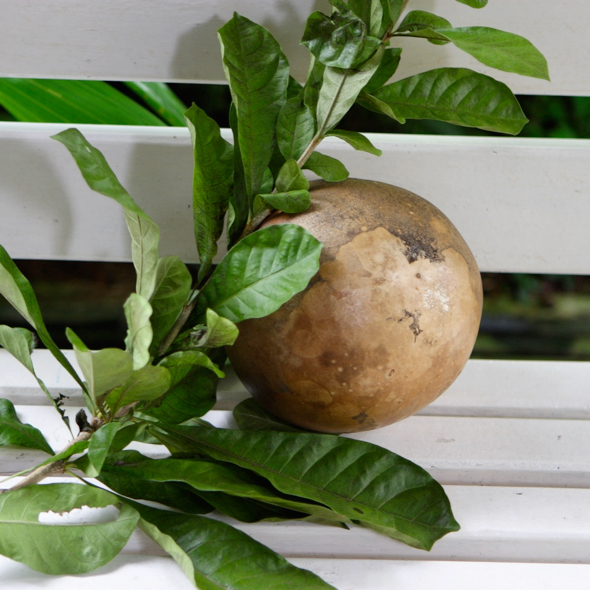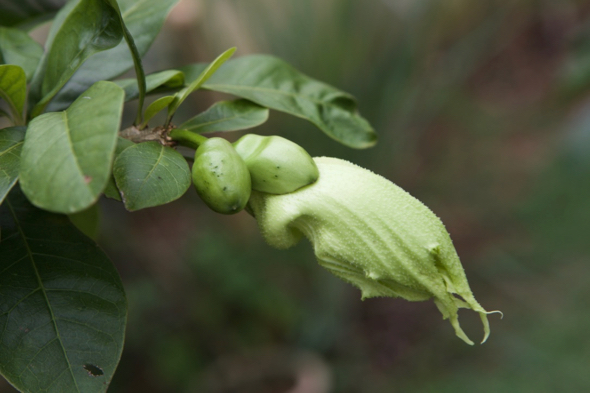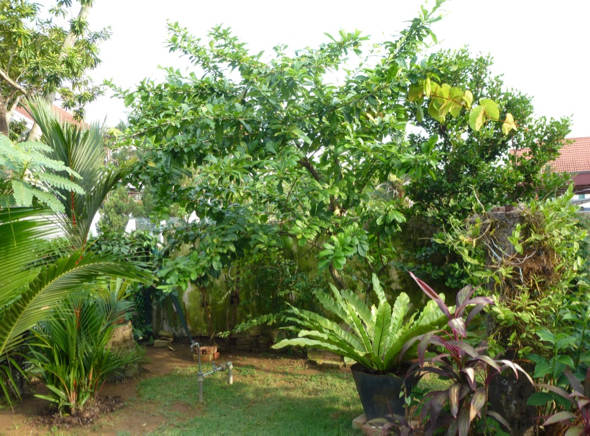
In 2008 Tan Teo Seng brought me a fruit and a cutting of the Calabash Tree (Crescentia cujete) from his farm in Johor, Malaysia (above). I planted it in my garden and now, nine years later. it has fruited (below).
This is a medium-size tree with a relatively short trunk and spreading branches. It is native to the Caribbean, Central America, Mexico and South America.
Calabash Tree belongs to the plant Family Bignoniaceae that includes the common African Tulip (Spathodea campanulata) and exotics like Midnight Horror (Oroxylum indicum) and African Sausage Tree (Kigelia aethiopica) that can be found in the Singapore Botanical Gardens. The latter two trees are bat pollinated.

My Calabash Tree bears bell-like flowers. The buds arise from the larger as well as slender branches (above). They bloom in the evening (below) and by the next morning the rings of petals litter the ground below. What are left on the branches are the two sepals bearing a long style that ends in a two-lipped stigma. Surrounding the prominent ovary below is a yellowish nectary. This bare “flower” will end up on the ground the next day if there was no pollination (below). It is commonly reported that these flowers emit a strong foetid smell but the flowers in my garden only emit a faint fragrance.

For weeks, seeing the many petals littering below the tree every morning, I was wondering why fruits were not formed. Was it because there were no bats or moths in my urban garden to effect pollinating? I even tried artificial pollinating but without success.

Then one day Teo Seng visited my garden and I complained to him that while his trees fruit regularly, mine had yet to do so. A few days later another visitor visited and spotted a small green fruit. I had missed it as the young fruit was perfectly camouflaged against a thick background of green foliage. Spotting one fruit led to three others, bigger than the first. Within weeks the fruits grew and now they have a diameter of 20 cm (above). Very soon they will ripen and turn brown.
So my tree does fruit after all. Some animals (bats or moths) must have pollinated the flowers. My next assignment is to seek out the pollinating agent/s.
As with most plants the Calabash Tree has its medicinal uses. Valkenburg & Bunyapraphatsara (2002) provide some information. The internet gives forth plenty – here are three links – LINK 1; LINK 2; LINK 3. The leaves, bark and fruits are widely used in folk medicine. Depending on countries, certain parts are used as laxative and pain killer, to treat coughs, fever and inflammation or to stop bleeding and expel intestinal worms. Also, the dried fruit shells can be used as containers for holding food and water. And smaller fruits can be made into maracas.
YC Wee
Singapore
22nd September 2017
Reference:
van Valkenburg, J.L.C.H. & N. Bunyapraphatsara (eds.) (2002). Plant resources of South-East Asia No. 12(2). Medicinal and poisonous plants 2. Prosea Foundation, Bogor, Indonesia. 782 pp.










5 Responses
Very interesting! How long does this tree usually take to mature and bear fruit? What do you intend to use the fruits for?
My plant took 9 years to bear fruits. The furies are medicinal and my Philippina helpers plan to taste the fruit concoction before I do. I intend to try photograph
bats pollinating the flowers, if bats are the pollinator.
I was under the impression that the flowers and fruits of Crescentia cujete are cauliflorous (developing on the main stems or woody branches). Most of the trees I’ve seen in India process this character. Is it because this tree has been propagated through cuttings (and not through seeds), the fruits are formed on shoots?
Planting from seeds or from cuttings should not make any difference in where the fruits eventually develop – branches or trunk. It is possible that there are cultivars that vary in truly cauliflory to partially cauliflory. I have come across plants that are not cauliflorous when searching in the internet.
Hi! We currently have a flowering calabash tree, but all the flowers *including the little buds of fruits* falls down. No fruits are being produced.
I wonder how this tree can bear fruit? There are moths, butterflies, bees, and bats in here. However, I haven’t seen any of them visiting the tree.